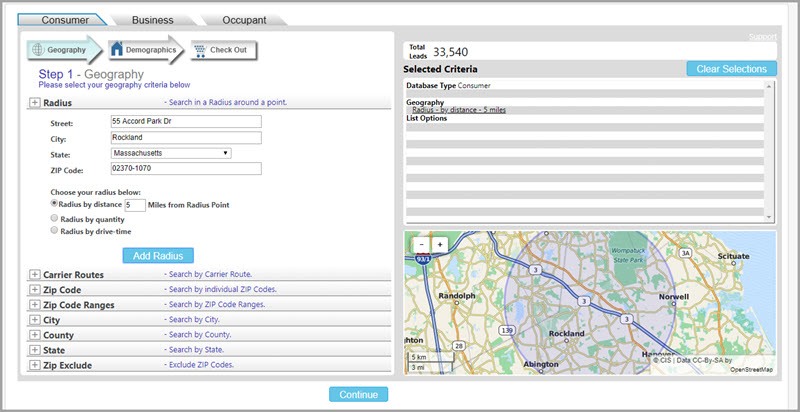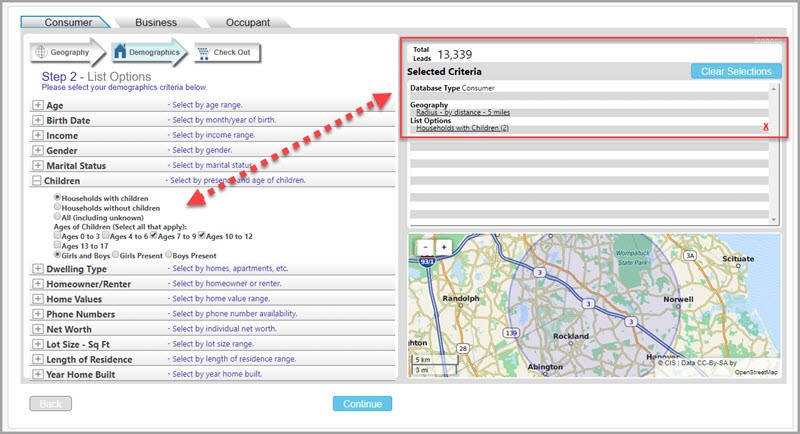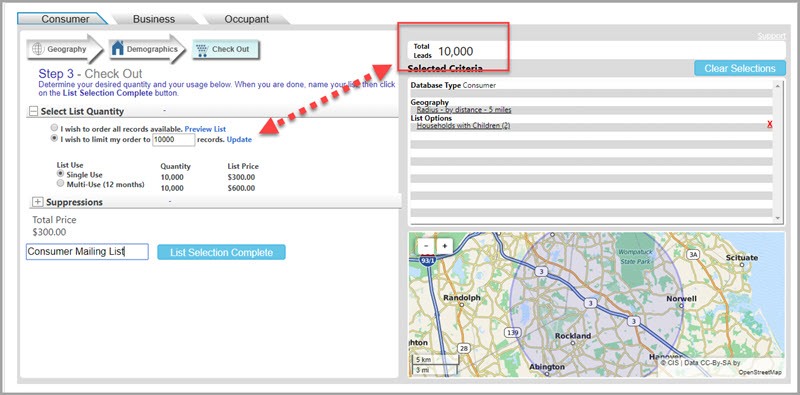
Can the right consumer mailing list light a fire under your B2C lead generation program?
Over the past few years, leading consumer brands are turning more and more to direct mail — which has reemerged as one of the most effective and personalized communication channels available for B2C marketers.
I say “reemerged” because for close to 100 years, direct mail was one of only a few forms of media that could target consumers directly to sell products directly and generate sales leads. Then B2C marketers discovered how online and email media seemed to offer the same benefits, but at a much lower cost.
So why the direct mail comeback? As more brands began focusing on online media, it became a noisy, crowded and increasingly expensive way to capture a consumer’s attention in a meaningful way.
Think about your own email inbox:
How many emails do receive per day? On some days I see 100 or more!
How many pieces of direct mail do you receive in a day? Maybe a dozen — if that?
Get A Free Postalytics Account
Direct Mail Marketing Stands Out
It’s so easy to overlook an email or just click “delete,” but actual mail in your mailbox is hard to ignore, especially if it’s compelling and relevant. That’s why more and more consumer brands — especially newer ones such as Facebook, and ecommerce brands such as Wayfair and Harry’s — are turning to direct mail to reach consumers. even to reach millennials who grew up communicating online.

What’s more exceptional is that consumers trust direct mail more than other media — almost twice as much as social media ads and email.
At 9% (house list) and 5% (prospect list), direct mail response rates are 9X and 5X higher than that of email, paid search and social media — with online display at a dismal 0.3%. (Source: Warranty Week)
One benefit to online media is that it’s easy to track response, but new technologies make it easy to track offline media such as direct mail, too.
With modern direct mail automation, you can personalize direct mail not only by name and address, but also by adding a customized personal URL (pURL) consumers can use to respond to your offer. Each unique pURL is automatically generated as your direct mail is printed, so you can easily test offers and consumer mailing lists.
Check Out Automated Direct Mail Pricing
As I pointed out in my recent “ultimate guide” to targeted mailing lists, the audience you select can make an enormous difference in your response rate. Even the most enticing direct mail offer won’t work well if it’s sent to a poor list. But with a well-targeted list, direct mail can easily become your best performing B2C lead generation channel.
Much of that success comes from testing lists and offers. Sometimes I see marketers run one direct mail campaign, receive average to poor results, and conclude direct mail “doesn’t work.” That’s a shame because for any offer, various audience segments respond differently — and direct mail makes it easy to test specific segments of B2C mailing lists.
After all you can’t treat “consumers” as a unilateral group. What may work for one type of consumer may not work well at all for others.
A well-designed test helps you narrow your audience down to the best consumer segments for your brand and offer. This allows you to add prospects to your database (even capture email addresses) while weeding out segments that don’t perform well.
How to find the best consumer lists and test audience segments
Here’s an example that shows how audience segmentation and testing your targeted mailing list can help you generate more response at a lower cost.
Let’s say that you’re offering an e-learning solution to families with children in school.
If
you order a basic consumer mailing list, it will likely contain plenty of households
with school-age children — and plenty that don’t. If half of your list includes
households with no children at all, your cost per response will be likely soar
much higher than necessary.
Let’s say you’re running a lead generation campaign, and you send 20,000 direct mail pieces at a cost of 85 cents each ($17,000). You get 350 responses, that represents a response rate of 1.75% and a cost per response of $48.57 each. But if those results are analyzed by segments — say, families with children — that analysis might resemble this:

*assuming 85 cents per piece
It’s logical, of course, that more than 90% of your responses came from households with children, so it’s clear that for an offer like this, it’s essential to select a B2C mailing list that eliminates families with no children. If you’d eliminated that segment, your cost per response would be $26.15.
Fortunately, Postalytics makes it easy to customize your list like this. Even better, you can refine your selection by age range. If you analyzed the results from this mailing even more precisely, you might find that age of children in households makes a difference —insights you can use to plan additional mailings to generate even more leads.
If the results above were analyzed by the age of children in a household, perhaps the results might look like this:

*assuming 85 cents per piece
You can see that your cost per response varies based on the age range. In fact, the group with children age 7 to 12 delivered a cost per response of only $21.25.
Get a great mailing list by talking to an expert
Mailing lists have traditionally been sold or rented through list compilers or brokers. These are businesses that focus on either pulling together lists from various sources or who represent/sell for multiple list providers.
Some compilers and brokers are better than others. Just like any other business.
Reputable ones know far more about the lists they sell than others. Make sure you research your potential list partner and make sure that they’re reputable.
Consumer Mailing List “Selects”
The mailing list world, like many business categories, has it’s own set of jargon. One of the most important phrases that you’ll here is the word “Selects”.
Essentially, a “Select” is a filter, typically geographic or demographic in nature, on a massive list. The more selections you make, the more narrowly you are defining your list. Highly targeted lists, with many selects, can cost more than more general lists. Typically because they are of higher value.
You can select specific geographical areas — defined as broadly as states and counties, or more precisely — by address radius, town, Zip Code, groups of Zip Codes, or even specific postal carrier routes.
What offers even more value is that you can segment lists not just by geography, but by other characteristics that include:
- Demographics, such as age, date of birth, gender, marital status, size of family, age of children, and more
- Dwelling types, so you can select or exclude homes, apartments, or mobile homes — and mail to homeowners, renters, or both
- Economic attributes, including income, value of home, and individual net worth
- Phone numbers, which can be added to your list when available
If you use your list within Postalytics, a key advantage is that because we monitor deliveries, we know when a specific piece isn’t delivered so we can immediately remove that name from the list.
This is important because experienced marketers know that best practices often require mailing to the same consumer list four to seven times over the course of a campaign.
There are few certainties in the world of marketing, but I guarantee you this: The response rate from a segment of mail that’s not delivered will always be 0%.
If you’re not a Postalytics user yet, you can create a free account and instantly see how this valuable feature works.
How To Create A Great Consumer Mailing List
Many list compilers and brokers have tools that enable you to select your list parameters online. They often look something like this.
Step 1: Select Your Mailing List Geography
The first step to define your consumer mailing list is to select a geographical area. You have several choices, including a geographic radius, zip codes, cities, counties, states and more.

In this case, we’ve selected a radius of 5 miles surrounding our office address. As you can see, the tool has uncovered more than 33,000 consumer leads within this 5-mile radius.
Step 2: Focus On Your Best Audience With Demographic Selections
In the example above, we showed how a highly targeted consumer mailing list of households with children between the ages of 7 and 12 was the prime audience for our campaign. To make this demographic selection, all you need to do is check a box as shown here:

By selecting this prime audience within our target geography, we’ve narrowed the list down from 33,000 to 13,339 potential leads for our mailing list.
As you can see, there are many other ways to narrow a list, including age of consumer, income level, gender, marital status, net worth and more.
Step 3: Review Choices And Purchase
The last step allows you to preview sample records from your list, choose whether you want to use the mailing list one time or in multiple campaigns, and define a maximum list size.
In this case, we’ll limit our list to 10,000 to meet budgetary requirements. As you can see, using this targeted mailing list for a single campaign will cost only $300 or only $600 for unlimited use of the list for a full year.

Now all you need to do is check out and start mailing!
Note that pricing for some selection criteria are a bit more expensive than others, but well worth the extra cost if a special affluence level or other factors are relevant to your offer.
Consumer Mailing Lists Power Great Results
As I mentioned at the beginning of this post, leading brands are turning more and more to direct mail for B2C lead generation because this unique channel captures far more attention than online advertising or email.
But it’s essential that you select the right mailing list segments. Experienced direct mail professionals know that by constantly testing offers and list segments, they can use their marketing budget far more effectively to reduce their cost per response and add new customers they can mail to again and again.
While many reputable mailing list brokers can help you select a good consumer mailing list, the process can be time-consuming and cumbersome. And any inaccuracies that may surface do so at the worst possible time — just as you’re ready to print and mail.
But through Postalytics platform, you can quickly and easily explore various consumer mailing list segments without delay — to choose specific geographic and demographic attributes in a process that takes just a few minutes. So go ahead and give it a try. If you’re not already a Postalytics customer, simply create a free account to see how easy it can be to power exceptional results for your next consumer direct mail campaign.
Watch Direct Mail Automation Overview Video
About the Author

Dennis Kelly
Dennis Kelly is CEO and co-founder of Postalytics, the leading direct mail automation platform for marketers to build, deploy and manage direct mail marketing campaigns. Postalytics is Dennis’ 6th startup. He has been involved in starting and growing early-stage technology ventures for over 30 years and has held senior management roles at a diverse set of large technology firms including Computer Associates, Palm Inc. and Achieve Healthcare Information Systems.
